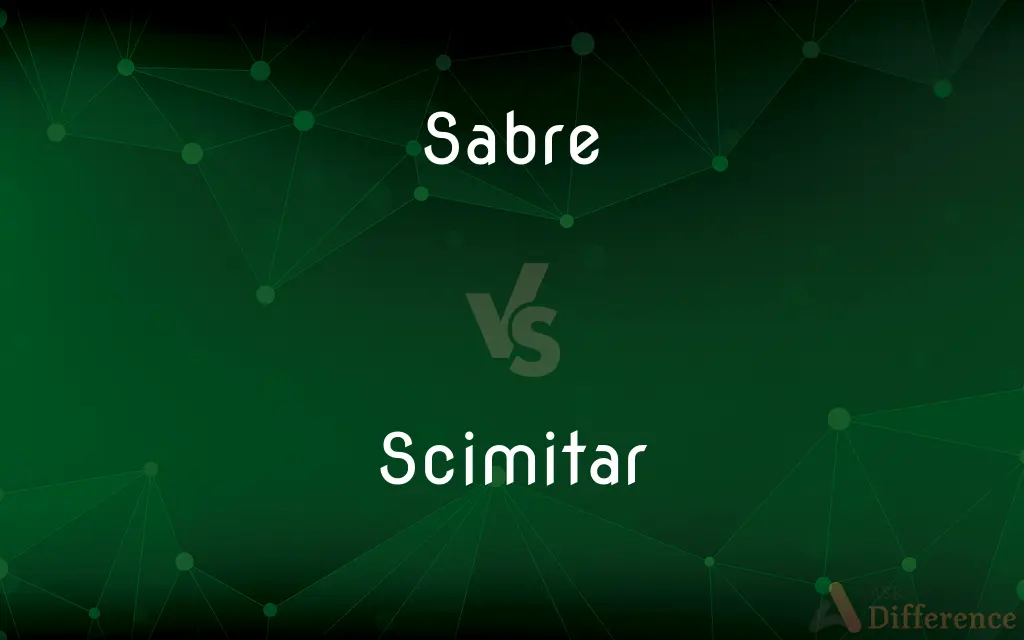Sabre vs. Scimitar — What's the Difference?
By Fiza Rafique & Urooj Arif — Updated on April 4, 2024
A sabre is a type of curved, single-edged sword originally used by cavalry, known for its slashing ability, while scimitar is specific type of broad, curved sword originating in the Middle East, characterized by its distinct curve and sharp cutting edge.

Difference Between Sabre and Scimitar
Table of Contents
ADVERTISEMENT
Key Differences
Sabres have a diverse history and usage across various cultures, often associated with military and ceremonial roles in European, American, and other cavalry units. Scimitars, however, are deeply rooted in Middle Eastern, Persian, and Ottoman cultures, symbolizing the martial prowess and cultural heritage of these regions.
While both swords are curved, sabres typically feature a moderate curve suitable for both slashing and thrusting. Scimitars, on the other hand, usually display a more pronounced curve, designed primarily for slashing, making them highly effective in mounted combat.
The design of sabres can vary significantly, ranging from the slightly curved European models to the more pronounced curves seen in the Eastern variants. Scimitars, such as the Persian shamshir, often have a continuous curve and a narrower blade, optimized for fast, sweeping cuts.
In terms of use, sabres were widely adopted by cavalry units in the 19th and early 20th centuries, favored for their effectiveness in fast-paced, close-range combat. Scimitars, with their origins in the East, were used in a similar manner but are often more closely associated with specific historical periods and regions, such as the Ottoman Empire and the Persian warriors.
Comparison Chart
Origin
Europe, America, and others
Middle East, particularly Persian and Ottoman cultures
ADVERTISEMENT
Blade Curve
Moderate, versatile for slashing and thrusting
Pronounced, designed primarily for slashing
Historical Usage
Military and ceremonial, widely used by cavalry
Martial prowess, closely associated with Middle Eastern warriors
Design Variability
Wide range, from slight to pronounced curves
Typically features a continuous, pronounced curve
Cultural Significance
Associated with a broad range of cavalry units across cultures
Symbolizes the martial heritage of the Middle East
Compare with Definitions
Sabre
Adopted in various cultures with modifications.
The Polish sabre, known as the szabla, features a distinct design suited to their fighting style.
Scimitar
A broad, curved sword originating from the Middle East.
The warrior’s scimitar gleamed under the desert sun.
Sabre
Features a single-edged blade, often with a protective guard.
The sabre’s guard offered protection to the wielder's hand during duels.
Scimitar
Features in cultural and historical lore.
Folk tales often depict heroes armed with scimitars battling evil forces.
Sabre
Used in modern fencing to refer to a specific discipline.
She won the gold medal in sabre at the fencing championship.
Scimitar
Known for its sharp edge and distinct curve.
The scimitar’s design made it ideal for mounted warfare.
Sabre
A type of sword with a curved blade, used historically by cavalry.
The officer carried a ceremonial sabre at the parade.
Scimitar
Symbolizes speed and precision in battle.
Legends tell of heroes wielding scimitars with unmatched speed.
Sabre
A sabre (sometimes spelt saber in American English) is a type of backsword with a curved blade associated with the light cavalry of the early modern and Napoleonic periods. Originally associated with Central European cavalry such as the hussars, the sabre became widespread in Western Europe in the Thirty Years' War.
Scimitar
Often associated with Persian and Ottoman warriors.
The Ottoman janissaries were feared for their proficiency with the scimitar.
Sabre
Variant of saber.
Scimitar
A scimitar ( or ) is a backsword or sabre with a curved blade typically associated with Middle Eastern, South Asian, or North African cultures.
Sabre
A light sword, sharp along the front edge, part of the back edge, and at the point.
Scimitar
A curved Asian sword with the edge on the convex side.
Sabre
A modern fencing sword modeled after the sabre.
Scimitar
A sword of Persian origin that features a curved blade.
Sabre
See Saber.
Scimitar
A long-handled billhook.
Sabre
A fencing sword with a v-shaped blade and a slightly curved handle
Scimitar
(transitive) To strike or slice with, or as if with, a scimitar.
Sabre
A stout sword with a curved blade and thick back
Scimitar
A curved oriental saber; the edge is on the convex side of the blade
Sabre
Cut or injure with a saber
Common Curiosities
Can sabres and scimitars be used for thrusting?
Sabres, with their moderate curve, can be used for thrusting and slashing. Scimitars, due to their pronounced curve, are primarily designed for slashing.
Were scimitars used exclusively in the Middle East?
While scimitars have their origins in the Middle East, similar designs were adopted in various regions, influenced by trade and conquest.
Are there fencing styles specific to sabres or scimitars?
Modern fencing includes a discipline for the sabre. While there's no competitive fencing style for scimitars, historical martial arts practices have sought to revive and preserve traditional techniques associated with both protectors.
Has the design of sabres and scimitars evolved over time?
Yes, both have evolved to suit the needs of the warriors using them, influenced by changes in armor, warfare tactics, and aesthetic preferences.
Which is better for combat, a sabre or a scimitar?
It depends on the context and style of combat. Sabres are versatile for various fighting techniques, while scimitars are excellent for swift slashing attacks, particularly from horseback.
What is the historical significance of sabres and scimitars?
Both have rich cultural and military histories. Sabres symbolize the valor of cavalry units, while scimitars represent the martial heritage of the Middle East.
Are replicas of historical sabres and scimitars available for collectors?
Yes, replicas are widely available for collectors and enthusiasts, ranging from decorative pieces to battle-ready protector.
How do the handles of sabres and scimitars differ?
Handles can vary widely, but sabres often have a hilt with a guard for protection, while scimitar hilts are designed to complement the blade's curve, focusing on grip and balance for slashing.
Do modern armed forces still use sabres?
Today, sabres are primarily used for ceremonial purposes rather than combat by military units around the world.
What kind of maintenance do sabres and scimitars require?
Like all bladed weapons, they require regular cleaning, oiling, and sharpening to preserve their condition and effectiveness.
Share Your Discovery

Previous Comparison
Greaseboard vs. Whiteboard
Next Comparison
Reciprocal vs. NonreciprocalAuthor Spotlight
Written by
Fiza RafiqueFiza Rafique is a skilled content writer at AskDifference.com, where she meticulously refines and enhances written pieces. Drawing from her vast editorial expertise, Fiza ensures clarity, accuracy, and precision in every article. Passionate about language, she continually seeks to elevate the quality of content for readers worldwide.
Co-written by
Urooj ArifUrooj is a skilled content writer at Ask Difference, known for her exceptional ability to simplify complex topics into engaging and informative content. With a passion for research and a flair for clear, concise writing, she consistently delivers articles that resonate with our diverse audience.
















































